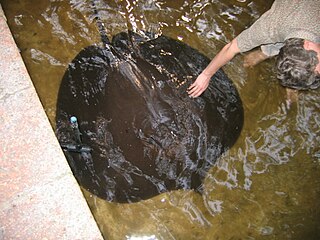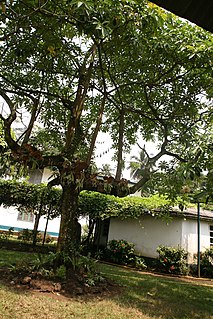Related Research Articles

In physical geography, a fjord or fiord is a long, narrow inlet with steep sides or cliffs, created by a glacier. There are many fjords on the coasts of Alaska, Antarctica, British Columbia, Chile, Denmark, Germany, Greenland, the Faroe Islands, Iceland, Ireland, Kamchatka, the Kerguelen Islands, Labrador, Newfoundland, New Zealand, Norway, Novaya Zemlya, Nunavut, Quebec, Russia, South Georgia Island, Tasmania, United Kingdom, and Washington state. Norway's coastline is estimated to be 29,000 km (18,000 mi) long with its nearly 1,200 fjords, but only 2,500 km (1,600 mi) long excluding the fjords.

The Murray cod is a large Australian predatory freshwater fish of the genus Maccullochella in the family Percichthyidae. Although the species is called a cod in the vernacular, it is not related to the Northern Hemisphere marine cod (Gadus) species. The Murray cod is an important part of Australia's vertebrate wildlife—as an apex predator in the Murray-Darling River system—and also significant in Australia's human culture. The Murray cod is the largest exclusively freshwater fish in Australia, and one of the largest in the world. Other common names for Murray cod include cod, greenfish, goodoo, Mary River cod, Murray perch, ponde, pondi and Queensland freshwater cod.

Lake Beyşehir is a large freshwater lake in Isparta and Konya provinces in southwestern Turkey. It is located at around 37°47′0″N31°33′0″E and is the largest freshwater lake in Turkey. It has an area of 650 km² and is 45 km long and 20 km wide. It carries the same name as the principal urban centre of its region, Beyşehir. Anciently, it was considered part of ancient Isauria.

The giant freshwater stingray is a species of stingray in the family Dasyatidae. It is found in large rivers and estuaries in Southeast Asia and Borneo, though historically it may have been more widely distributed in South and Southeast Asia. The largest freshwater fish and the largest stingray in the world, this species grows up to 2.2 m (7.2 ft) across and can reach up to 300 kg (660 lb) in weight. It has a relatively thin, oval pectoral fin disc that is widest anteriorly, and a sharply pointed snout with a protruding tip. Its tail is thin and whip-like, and lacks fin folds. This species is uniformly grayish brown above and white below; the underside of the pectoral and pelvic fins bear distinctive wide, dark bands on their posterior margins.

A pond is an area filled with water, either natural or artificial, that is smaller than a lake. Ponds are small bodies of freshwater with shallow and still water, marsh, and aquatic plants. Ponds can be created by a wide variety of natural processes, or they can simply be isolated depressions filled by runoff, groundwater, or precipitation, or all three of these. They can be further divided into four zones: vegetation zone, open water, bottom mud and surface film. The size and depth of ponds often varies greatly with the time of year; many ponds are produced by spring flooding from rivers. Ponds may be freshwater or brackish in nature. 'Ponds' with saltwater, with a direct connection to the sea that maintains full salinity, would normally be regarded as part of the marine environment because they would not support fresh or brackish water organisms, so not really within the realm of freshwater science.

The West Spitsbergen Current (WSC) is a warm, salty current that runs poleward just west of Spitsbergen,, in the Arctic Ocean. The WSC branches off the Norwegian Atlantic Current in the Norwegian Sea. The WSC is of importance because it drives warm and salty Atlantic Water into the interior Arctic. The warm and salty WSC flows north through the eastern side of Fram Strait, while the East Greenland Current (EGC) flows south through the western side of Fram Strait. The EGC is characterized by being very cold and low in salinity, but above all else it is a major exporter of Arctic sea ice. Thus, the EGC combined with the warm WSC makes the Fram Strait the northernmost ocean area having ice-free conditions throughout the year in all of the global ocean.
Ellobiopsis is a genus of unicellular, ectoparasitic eukaryotes causing disease in crustaceans. This genus is widespread and has been found infecting copepods from both marine and freshwater ecosystems. parasitism has been seen to interfere with fertility in both sexes of copepods.

Reticulomyxa is a monospecific genus of freshwater foraminiferans. The type species is the unicellular Reticulomyxa filosa. It is found in freshwater environments as well as moist environments, like decomposing matter and damp soils. The heterotrophic naked foraminiferan can feed on microbes as well has larger organisms and is able to be sustained in culture by supplemented nutrients such as wheat germ and oats. The large, multinucleate foraminferan is characteristic for its lack of test and named for the network of connecting pseudopodia surrounding its central body mass. The organism has unique bidirectional cytoplasmic streaming throughout the anastomosing pseudopodia that is some of the fastest reported organelle transport observed. Reticulomyxa was first described in 1949 and is commonly used as a model organism for the unique transport of organelles throughout the cytoplasm of pseudopodia by cytoskeletal mechanisms. Only asexual reproduction of this genus has been observed in culture, but the genome possesses genes related to meiosis suggesting it is capable of sexually reproductive life stages.
Neobodo are diverse protists belonging to the eukaryotic supergroup Excavata. They are Kinetoplastids in the subclass Bodonidae. They are small, free-living, heterotrophic flagellates with two flagella of unequal length used to create a propulsive current for feeding. As members of Kinetoplastids, they have an evident kinetoplast There was much confusion and debate within the class Kinetoplastid and subclass Bodonidae regarding the classification of the organism, but finally the new genera Neobodo was proposed by Keith Vickerman. Although they are one of the most common flagellates found in freshwater, they are also able to tolerate saltwater Their ability to alternate between both marine and freshwater environments in many parts of the world give them a “cosmopolitan” character. Due to their relatively microscopic size ranging between 4-12 microns, they are further distinguished as heterotrophic nanoflagellates. This small size ratio limits them as bacterivores that swim around feeding on bacteria attached to surfaces or in aggregates.
Pseudobowmanella is a Gram-negative, facultatively anaerobic, rod-shaped and motile bacteria genus from the family of Alteromonadaceae with one known species. Pseudobowmanella zhangzhouensis has been isolated from wather from the Jiulong River in China.
Kordia is a Gram-negative, strictly aerobic and non-motile genus of bacteria from the family of Flavobacteriaceae.
Kordia algicida is an algicidal, Gram-negative, strictly aerobic and non-motile bacterium from the genus Kordia which has been isolated from sea water from the Masan Bay in Korea.
Kordia antarctica is a Gram-negative, chemoheterotrophic, facultatively anaerobic and non-motile bacterium from the genus Kordia which has been isolated from seawater from the Antarctic.
Kordia aquimaris is a Gram-negative, strictly aerobic, non-spore-forming and non-motile bacterium from the genus Kordia which has been isolated from seawater from the coast near the Taichung harbour in Taiwan. Kordia aquimaris produces zeaxanthin.
Kordia jejudonensis is a Gram-negative, aerobic, non-spore-forming and rod-shaped bacterium from the genus Kordia.
Kordia periserrulae is a Gram-negative, chemoheterotrophic and facultatively anaerobic bacterium from the genus of Kordia which has been isolated from the worm Periserrula leucophryna from the Yellow Sea in Korea.
Kordia ulvae is a Gram-negative, aerobic and rod-shaped bacterium from the genus Kordia which has been isolated from the alga Ulva.
Kordia zosterae is a Gram-negative and rod-shaped bacterium from the genus of Kordia which has been isolated from the seaweed Zostera marina from the Yellow Sea in Korea.

Alstonia congensis, is a tree within the Apocynaceae family and one of two African species within the Alstonia genus, the other being the Alstonia boonei De Wild. Both have similar morphological characteristics.
Olleya sediminilitoris is a Gram-negative bacterium from the genus of Olleya which has been isolated from tidal flat sediments from the Yellow Sea.
References
- 1 2 "Species: Kordia zhangzhouensis". LPSN.DSMZ.de.
- 1 2 Du, Juan; Liu, Yang; Lai, Qiliang; Dong, Chunming; Xie, Yanrong; Shao, Zongze (1 October 2015). "Kordia zhangzhouensis sp. nov., isolated from surface freshwater". International Journal of Systematic and Evolutionary Microbiology. 65 (Pt_10): 3379–3383. doi: 10.1099/ijsem.0.000424 . PMID 26297493.
- ↑ "www.uniprot.org".
{{cite journal}}: Cite journal requires|journal=(help)